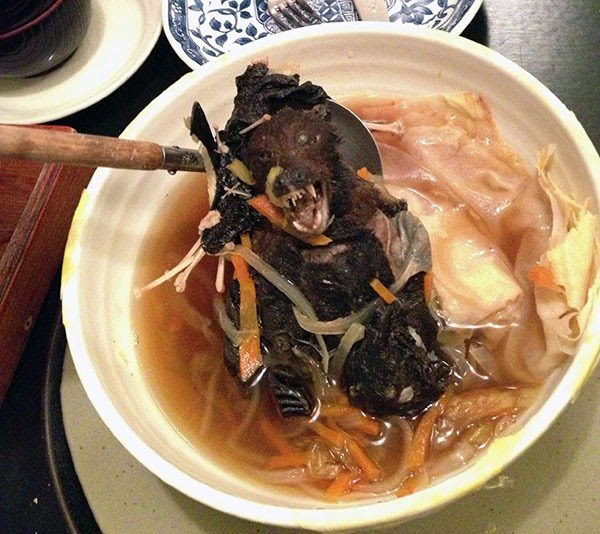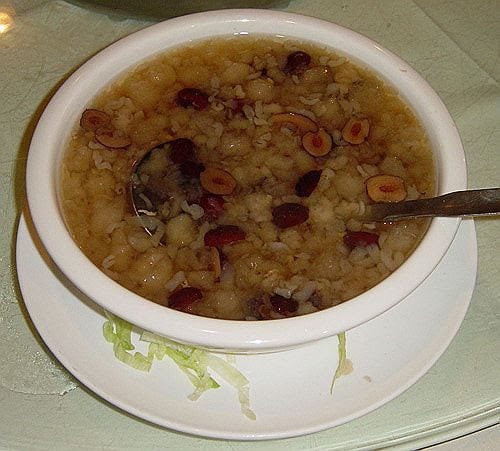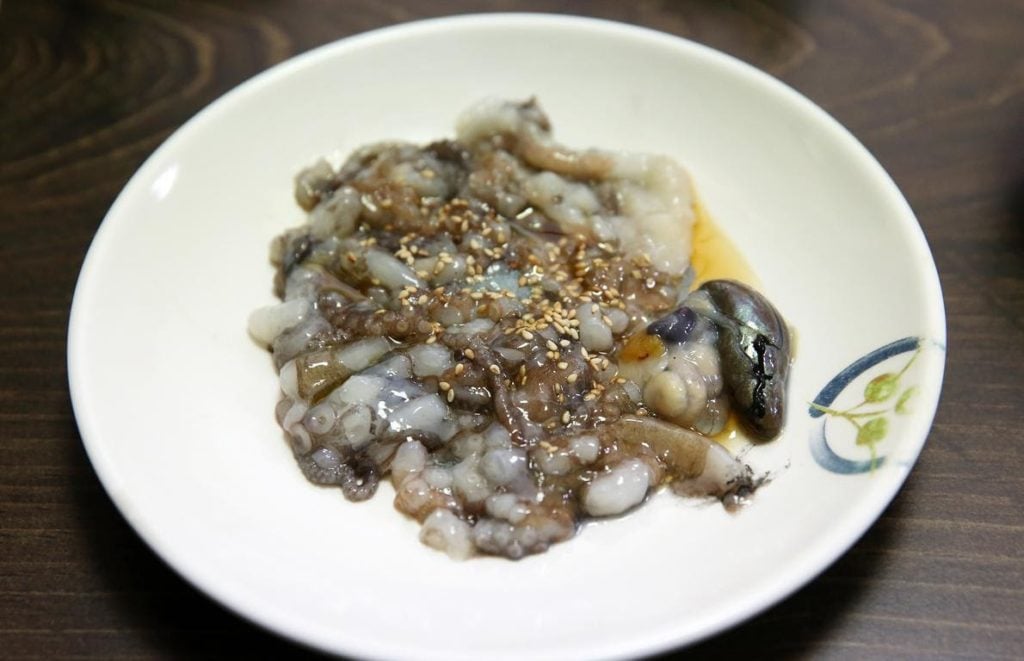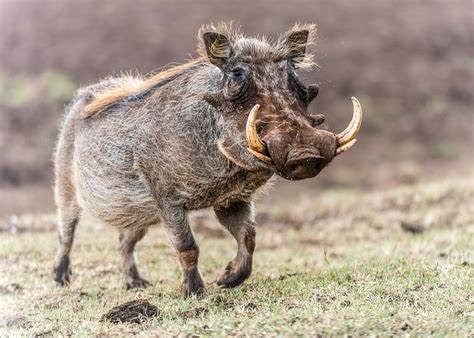We won’t ask why you’ve clicked on this article, but we’re guessing you are either incredibly curious or you’re fancying skipping your next meal. There’s always something oddly satisfying about learning about some of the world’s most disgusting foods, right?
While the world is full of delicious foods, there are some foods out there that many of us would be reluctant to try. Whether it’s because they look disgusting or have unfamiliar flavors, these foods are not for the faint of heart. And yes, in the U.S., we also have disgusting food.

Everyone has their own unique tastes when it comes to food, but some dishes from around the world might make even the most adventurous eaters think twice. In this article, we will explore some of the most disgustingly intriguing culinary delights known to humanity. From insect-based dishes to pungent fermented foods, it seems that some people have developed a taste for the bizarre and, at times, the downright nauseating.
While some of these dishes can be found in remote corners of the globe, others have become popularized as trendy delicacies. The cultural significance and history behind these foods bring a fascinating element to each bite—if you can stomach the taste, that is. It is interesting to see how our acceptance of certain flavors and textures changes when faced with the unfamiliar. Put on your culinary adventure hat and join us as we delve into the world of the most disgusting foods.
We don’t intend to gross you out here. Instead, we want to educate you on time-honored traditions across the globe that are complete with some of the most…interesting foods. For the thrill-seekers who want to expand their culinary horizons, we hope you can find something that tickles your taste buds. This guide to the world’s most disgusting foods won’t exactly be pretty, but we hope it gives you an interesting insight into cultural traditions and delicacies.
Balut – Philippines and Vietnam

Yeah, we told you this list wasn’t gonna be pretty. Balut is commonly found as a street food delicacy in both the Philippines and Vietnam. It is usually either a chicken or duck embryo that is boiled alive and eaten straight out of the shell. Duck is the most common form of Balut. Duck eggs usually hatch between 27 and 30 days, but eggs that are sold as Balut are developed for 16 to 25 days and then boiled in the shell. Inside the shell, you will see a small duckling or chick surrounded by the contents of a regular hard-boiled egg. Balut is mostly found at street vendors for tourists who want to try this gross egg, but for the locals, Balut is usually prepared and eaten at special occasions and religious events. Tourists are recommended to order “Balut su pati”, which translates to “Balut in white”, as the duckling or chick embryo is covered in egg white to make it look less unappetizing. The way to eat Balut is simple – you tap a hole in the egg and slurp out the insides. If you’re feeling particularly brave, you then open up the egg to eat the duckling or chick embryo whole.
Fried Tarantula – Cambodia

Cambodian fried tarantulas are one of the most popular street foods in the whole country. Almost every thrill-seeker has wanted to take a bite out of one of their hair, crispy, deep-fried legs. The best fried tarantulas are found in the small city of Skuon, which is aptly nicknamed Spiderville. These tarantulas are caught by hand by experts who know how to handle them, who then remove their poisonous fangs. Hey, you’re gonna want to bite it before it bites you, right? The tarantulas are then rolled in a mixture of garlic, salt, seasoning, and sugar and then deep-fried alive in oil. The legs are said to be crispy and fairly tasty, but the body is soft and explodes inside the mouth. It is said to be full of zinc, protein, and folic acid, though. The reason these spiders are considered a delicacy in Skuon is that they can be sold for $1 each, where the national average wage is $6 a day. Some street vendors can sell dozens if not hundreds a day, so it’s a brilliant source of income.
Cobra Heart – Vietnam

Vietnam’s capital, Hanoi, is known for its snake village and unique dishes that contain snake as the main ingredient. Whether you go to a street vendor at snake village or you find a lovely Vietnamese restaurant, chances are you will be offered a shot of a Cobra heart. At snake village, you will have to pick out your chosen Cobra. Then, wait around 15 minutes for the chef to dissect your snake, where they will take out the heart and dilute it with rice wine and a dash of snake blood. All you have to do is take it like a regular shot – except there’s a beating heart inside it. Here’s where it gets a bit weirder. Some shots contain bile, while others are filled with pure venom. Interestingly, they only allow the venom shots to those who have no cuts to the mouth, as the venom is only dangerous if it enters the blood. Otherwise, the stomach will just process the venom.
Eskimo Ice Cream / Akutaq – Alaska

Fancy soothing your sweet cravings? This Eskimo ice cream will do the trick. Well, the berries will. The actual ice cream itself is not what you’d think. Eskimo ice cream is an Alaskan delicacy that is made of either dried fish or moose or caribou fat. It’s usually a mixture of everything – including seal, reindeer, walrus tallow, salmon eggs, and of course, berries. It’s all whisked together to create a creamy substance that is eaten as a dessert. Modern versions of this dessert are made with milk and sweeteners to make it tastier. Traditionally, Alaskans sing native songs during the preparation of the dessert. They call the dessert “Akutaq”, which translates to “mix it together” in the Yupik language.
Whilst there are not many ingredients in Akutaq, the process requires a team effort. The men go hunting for the meat or fish, and the women prepare the meal. The mixture of protein in the meat and antioxidants in the fruit is why men like to eat this whilst on long hunting trips.
Vomit Fruit / Noni – Southeast Asia / Australasia / the Pacific

So far the foods on our list haven’t been vegan-friendly – which is why this is for the plant-based foodies out there! Noni is aptly known as “vomit fruit” for its distinctive, pungent vomit-like odor and taste. In some areas, its gross taste is what makes it a famine food for those in poverty because nobody else wants to eat them. However, in other places, it is a staple food that is often used in traditional medicines. The fruit, leaves, and root of the vomit fruit have been used for traditional medicines by Polynesians. It has also been used in cosmetic products before due to claims of health benefits – however, such claims are yet to be proven. In some Pacific Islands, vomit fruit is eaten either raw or cooked. It is usually eaten raw with salt or cooked in a curry by Southeast Asians and Australian Aboriginals. It can also be thrown into salads.
Casu Marzu / Maggot Cheese – Italy

Casu Marzu is aptly nicknamed “maggot cheese” because of its direct translation – “rotten cheese”. This Sardinian specialty is made of (usually delicious) Italian pecorino cheeses that are deliberately prepared to become a haven for maggots, putrefaction, and rot. Not exactly a vegetarian option. This fermentation process includes the removal of the top of the cheese so flies can lay eggs inside, which then work to digest the fats, leaving the inner cheese soft and like a liquid.
You eat it like you would a regular cheese – except there are worms and maggots that jump off the cheese as you eat it. It is said to taste exactly how you’d imagine it – completely pungent and absolutely disgusting. Casu Marzu used to be a traditional delicacy for Italians, but you can only get it on the black market now. Maggot cheese is actually illegal as it doesn’t meet the standards of sanitation. Wonder why…
Chapulines – Mexico

If you think you’re safe from seeing more pictures of edible bugs, think again. Enter Mexico’s grasshoppers – Chapulines. These grasshoppers are caught between May and September and toasted on a flat griddle called a comal. They are known for their crispy texture and oddly sweet, sour, and salty flavoring that is achieved through the seasoning of garlic, lime juice, salt, and sometimes other worm extracts. You can even get spicy Chapulines that are cooked with chilis. If you’re ever in Mexico and want to try one of these critters, you’ll find the best Chapulines in Oaxaca. They are usually mostly found at street vendors throughout the year as they are cooked in salt, so they don’t have a sell-by-date. Chapulines are now mostly eaten as a snack, but they used to be a huge source of food back in the 16th century when food wasn’t easily available. They are also found in burritos and tacos to give an extra crunch. Tasty!
Bat Soup – Thailand

Often called a “Bat paste”, this is potentially one of the most dangerous disgusting foods on our list. It’s ironic, because usually we eat food to keep us healthy and to support our immune system. That kind of goes out of the window with bat soup, as bats are notorious for carrying lethal diseases. Makes you wonder why on earth they are eaten in a soup…Bat soup is made by boiling a live bat in water until it softens. Then, the heat is turned down as you add seasonings, spices, and herbs. Sometimes, the smell of urine will emerge, which is usually reduced by the addition of beer or garlic. Bat paste is done in the same way, except the bat is crushed to a paste-like consistency.Bat soup actually derives from the Pacific island Palau, and has since become a delicacy in Thailand and some other Asian countries.
It was created in Palau because bats were the only other source of protein next to fish, and so the indigenous people had no choice but to consume them. Putting bats in a soup has somehow made them more bearable to eat, apparently.
Rocky Mountain Oysters – West America and Canada

We might have peacefully lulled you into a state of relief to see something so “normal” on our list. Be warned, these Rocky Mountain oysters aren’t all what they seem to be. Rocky Mountain oysters, or Prairie oysters, aren’t oysters at all. Instead, they are young bull testicles. Obviously, the dish won’t sell with a name like that, so they lure in unsuspecting customers with the word “oyster”. It’s not just limited to bull’s testicles, as they can also be made from pig or sheep testicles, too. Of course, customers should know what they’re in for. Rocky Mountain oysters are said to be rather tasty, apparently. The meat is said to be similar to venison, whilst the fried outer layer is similar to calamari. You just have to not think about what they actually are. If you’re wondering where this came from, the dish was created by Western ranchers who needed inexpensive and accessible food. The testicles of young bulls were removed to prevent their aggressive temper, so the ranchers decided to cook them instead.
Century Egg – China

Okay, so these eggs aren’t actually a hundred years old like the name suggests, but they are a hundred days old. Not like that makes it any more appetizing. Century eggs are a Chinese delicacy made by preserving the eggs of ducks, chickens, and quails. The eggs are preserved in a mixture of clay, salt, and ashes for usually 100 days depending on how they are processed.
This preservation process allows the eggs to “cook” themselves, as the once yellow yolk turns dark green and the egg white turns into a grey, ashy, gelatin-like consistency. They were first introduced by Chinese farmers in the Qing dynasty in the 1640s as a way to preserve eggs without refrigeration. As you can imagine, the flavor is overwhelming. It is said by the lovers of the dish that the flavors are enhanced the longer it stays preserved. Most people say it tastes earthy and slightly like ammonia, so take that as you will.
Hasma – China

Hasma is a popular Chinese dessert that features the fatty tissue around the fallopian tubes of frogs. The frogs in question are usually Asiatic grass frogs, if anyone cares to know. The fallopian tubes of the frogs are removed and dried, and later rehydrated so they swell in size – usually around 10 or 15 times bigger than usual. It is then cooked with a sweet soup and served as a dessert. A bunch of other ingredients are chucked in, such as jujubes, lotus seeds, dried longan fruits, and often a Chinese pear. Whilst there is no evidence of health benefits, Hasma is often taken as a traditional medicine for respiratory issues, stomach ulcers, and improving the quality of the skin. Who knew the frog fallopian tubes have aging properties (apparently)? It’s not often that people will eat Hasma as it is quite expensive, but it’s a yummy treat for those celebrating special occasions. Nothing quite says “Happy Birthday!” like a bowl of frog fallopian tubes.
Frog Sashimi – Japan

These poor frogs can’t get a break, can they? The Asadachi restaurant in Japan is notorious for its unique and rare dish – frog sashimi. Sashimi is sliced and raw seafood, and that’s the least gross part of this dish. The whole point of frog sashimi is the experience of having the food delivered to you. If you order this dish, you’re in for a treat. Or an absolute nightmare, depending on your perspective. When you order this dish, the chef will cut a live frog in front of your eyes, rip out its heart, and will serve it amongst the rest of the sashimi. In some cases, the chef will hand the beating heart directly to you with chopsticks, which you then eat as they slice the rest of the frog into the sashimi. This is an unsurprisingly rare dish in Japan, but definitely one to tick off the bucket list if you’re a thrill-seeker for culinary experiences. Frog sashimi is said to improve virility, because apparently there’s nothing quite as inherently masculine as eating live, uncooked frogs.
Jibachi Senbei / Wasp Rice Cracker – Japan

Fancy a sweet snack with a twist? Jibachi Senbei is one of Japan’s most unique rice crackers, as they contain the key ingredient that sets them apart from other rice crackers – wasps. Wasp traps are set in the Japanese village of Omachi, where the caught Digger Wasps are used for this sweet treat. The creation started from a fan club for Digger Wasps (we’re serious) who joined together with a local baker to experiment with cooking wasps in food. Picture these rice crackers like cookies with raisins. Except the raisins are wasps. The wasps are boiled and dried, and then added to a mildly sweet and savory rice cracker mix. The wasps are said to taste quite acidic. You’re probably going to get legs and wings stuck between your teeth, too. The Digger Wasp fan club continues to love and make Jibachi Senbei regularly depending on how many wasps they catch – whether it’s because of their deep love for wasps or the high protein content in the crackers, we don’t know.
Jellied Moose Nose – Canada

Moose meat isn’t exactly a rare or disgusting food in Alaska and Canada. It’s normal to find Moose sausages, Moose steak, and Moose pizza toppings as with any other meat. Jellied Moose nose is an exception, though. Can’t remember a time when jellied Sheep nose existed, so why Moose nose? Indigenous families were (and still are) notorious for minimal waste. When they have caught an animal, they will utilize every aspect of their body – including Moose.
Moose are characterized by their large snout, so it only makes sense to find ways to eat that, too. The nose is considered a delicacy amongst Indigenous communities as it is a hallmark of sacrificing and utilizing the entirety of the animal. To make jellied Moose nose, the fur is removed and the nose is sliced and simmered among onions, garlic, herbs, and spices like cinnamon. Other parts of the Moose, like the ears or lips, are often chucked into this mix. Waste not want not, right? The cooled meat is then laid in a loaf pan and poured over with broth, which is then left to solidify in the refrigerator. Once the mixture has solidified, the jellied Moose nose can be sliced like bread. The taste is said to be flavorsome, but most people tend to struggle with the different textures like the soft lips and chewy nose cartilage.
Black Pudding – UK and Ireland

Believe it or not, this might be the most edible disgusting food on our list. On paper, it sounds gross. In your mouth, you might find it quite tasty. You’ll only know if you try! Black pudding is often called “blood sausage” because it is primarily made from pig blood. The blood is mixed with pork fat or beef suet, along with oats or barley, and topped with some delicious thyme seasonings and spices.
Most parts of the UK and Ireland will make their black puddings differently depending on the region, so some black puddings might taste meatier whilst others will taste spicier. Black pudding was originally made around the 15th century when people were less likely to waste every part of an animal’s slaughtered body – including blood. Blood spoils quickly unless it is prepared and turned into something else, so black pudding was the only way to not waste the blood. This odd-looking sausage is typically eaten amongst a traditional English breakfast and can be celebrated at Normandy’s Black Pudding festival.
San-Nakji – Korea

San-nakji is one of the most infamously popular cuisines in the whole of Asia – more specifically Korea. This meal features a variety of hoe, which is essentially a mixture of different baby octopus tentacles mixed with sesame seeds and sesame oil. Whilst most people assume the octopus is still alive when the tentacles are cut off, this is actually a misconception. Octopuses have a unique nervous system where most of the neurons exist in the tentacles, so the tentacles will move even when the octopus is dead. You’re still eating the tentacles raw, though, so they are basically alive. Eating San-nakji is less about the taste and more about the experience of the texture. The tentacles are still moving and the suction cups can still work, so you’ve got to face a wriggling, squirmy, and sticky mess.
As there have been reports of the tentacles getting stuck down the throat and choking, customers must take their time to properly chew the tentacles before swallowing them.
Witchetty Grub – Australia

Witchetty grubs are large, wood-eating larvae. This larva is of the cossid moth, which eats the roots off witchetty bushes throughout the majority of Australia. They have always been a staple part of Australian Aboriginal’s diets. They are so loved by Aboriginal people that they often appear in their drawings and paintings. These funny-looking bugs are said to taste like almonds when eaten raw. They’re not something you will find in every Australian restaurant, that’s for sure, but that doesn’t mean there’s an odd shack or two across the country that sells native critters in food form. Most of the time, you’re safe to grab one of these bugs in the wild and eat them raw. Most people will say that Witchetty grubs taste much nicer when they are lightly cooked as the texture is more bearable. The skin becomes like a thin crispy chicken, whilst the insides resemble something like cottage cheese or scrambled eggs. If you are going to pick one of these bugs up in the wild to devour, make sure to avoid eating the head. The head of a Witchetty grub is its only defense, as it produces a brown liquid.
Milt / Soft roe – Russia / Europe / Japan

This dish doesn’t exactly look disgusting, but the contents of it definitely are. No, this isn’t some weird mayonnaise substance or candy. This is milt or soft roe – fish semen. For some reason, this odd meal is considered a delicacy in several countries across the world. Milt can be fried and served with horseradish, pickled, or eaten as a pasta topping. These sperm sacs are said to have a fishy taste and, once you forget about what you’re eating, are meant to be quite nice. In Japan, Shirako is a popular dish that translates to “white children” (we’ll leave that up to your imagination). It can be eaten grilled, fried, on top of rice, or even on top of custard. It is said that first-timers prefer Shirako that has been deep-fried in tempura batter, whilst experienced eaters will just devour them raw and on top of sushi. The types of fish that the milt is taking from are generally herring, tuna, cod, carp, pollock, sea bream, and snakeheads.
Medama / Tuna eyeball – Japan

You read that correctly – tuna eyeballs. Turns out they’re a popular snack in Japan and can be often found in supermarkets and fish markets. Tuna eyeballs are commonly found in Japanese bars called izakayas, and are sold as inexpensive snacks alongside drinks. Tuna eyeballs weren’t originally eaten in times of poverty like you would think. Instead, they became popular in the 90s when the Japanese media spoke about the positive health benefits of Omega 3 in the eyeballs. They have since become a supplement of sorts. These eyeballs can be served lightly steamed, boiled, stewed, or fried. The taste is meant to be overwhelmingly fishy, but the texture is the real standout feature. You have to break the glass of the eye with your teeth, and you will eventually come across a sack that will burst with liquid.
Warthog Anus – Namibia

Last but not least isn’t exactly a dish, but it can certainly be eaten. Warthog anus is a supposed rarity in Namibia, but when people are struggling with poverty and starvation, sometimes they have to make ends meet – even if it starts with the end of an animal. To cook a warthog anus, you must pull it out with one foot of the intestine attached, and then squeeze out everything inside. Don’t bother cleaning it, because it will be disgusting regardless. The key to cooking warthog anus is to cook it al dente, otherwise, it’s far too chewy. It’s said to be absolutely disgusting, and we’re not surprised why.


Nasty Foods: The World’s Most Disgusting Foods (With Pictures) (+Grilled Rocky Mountain Oysters)
Ingredients
- Fresh lamb or bull testicles
- Lemon juice
- Sea salt
- Black pepper
Instructions
- Season the testicles with black pepper and sea salt.
- Grill for 10-15 minutes until the outer sides are fully cooked and charred on all sides.
- Remove from the grill and slice into thick slices.
- Serve with fresh lemon juice.
Notes
Organize all the required ingredients.
Enjoy the food.
Nutrition
















